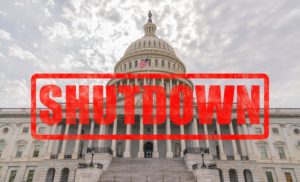Federal Government shutdown, continuing resolutions (CRs), and what contractors need to do
 Mark Amtower’s January 19, 2018 show on Federal News Radio discussed the Federal Government shutdown and related steps contractors need to take—as well as Continuing Resolutions (CRs) and past shutdowns from both the government and contractor points of view. The show also provided step-by-step guidance on how to minimize a shutdown’s impact on contractors, employees, and their customers.
Mark Amtower’s January 19, 2018 show on Federal News Radio discussed the Federal Government shutdown and related steps contractors need to take—as well as Continuing Resolutions (CRs) and past shutdowns from both the government and contractor points of view. The show also provided step-by-step guidance on how to minimize a shutdown’s impact on contractors, employees, and their customers.
Simon Szykman, former CIO of the Department of Commerce and NIST and current CTO of Attain, and Bob Lohfeld, CEO of Lohfeld Consulting Group, provide the commentary. The show is the first one that takes a close look at shutdowns and their impact on the contractor community.
Some of the interesting discussions during the broadcast include:
- Mark Amtower pointed out an appalling statistic from the Bipartisan Policy Center—from 1976 to present, there have only been four budgets passed on time. The last one passed on time was in 1996—22 years ago.
- What to do if you have a proposal due during a shutdown.
- What happens when the government starts operating again.
- What costs are associated with a government shutdown, including near-term financial costs, mission costs, and long-term impacts on the government/industry ability to perform.
Contractor shutdown triage process
Per Bob Lohfeld, contractors have a triage process they go through to look at the impact of a government shutdown, and this process needs to happen before the shutdown occurs. “The government doesn’t shut down in its entirety—different agencies shut down in different ways, or different segments of the agency shut down. So, as a contractor, you need to review all of your contracts and perform a triage process to basically divide them into four key categories:
- Those that are exempt, under the Anti-Deficiency Act;
- If it’s not exempt, the presumption is that you’ll continue to perform on that contract;
- Contracts that are impossible to perform because you can’t get access to the facility, you can’t get access to government people, you can’t get access to tools; or
- Ones where the contracting officer reaches out and says you have a stop work order. And, in those cases, you do indeed stop and begin accumulating your costs as you shut down, and hopefully you’ll start up again.”
For contracts where you’re a subcontractor, Bob advises, “You need to reach out to your prime contractor and go through the same triage. Ask them what they’re going to do. Well before a shutdown, you should be talking to your contracting officers and getting their guidance.”
Company communications plan
In a government shutdown scenario, you need a detailed communications plan the includes at a minimum:
- What, how, and when to communicate with your employees;
- What, how, and when to reach out to your prime contractors (as a sub) and your subcontractors (as a prime);
- What, how, and when to reach out to your contractor officer to discuss contract actions such as mods and options so you get those take care of before a shutdown occurs; and
- What, how, and when to talk to your bank as a small or mid-tier company regarding the financial impact of a shutdown.
What to do with employees during a shutdown
Companies have taken a variety of actions over the years for using employees who have been left “idle” by a shutdown. These include:
- Shifting them to other funded projects;
- Moving them to commercial work;
- Sending them to mandatory company training;
- Working on internal projects, including proposal development efforts; and
- Taking vacation, sick leave, or leave without pay.
In some cases, companies have gone out of business because they couldn’t absorb the costs of a government shutdown.
Contractor resources for addressing government shutdowns
To prepare for the next potential shutdown, check out these resources.
The Coalition for Government Procurement (CGP) provides an extensive list of resources on its website, including:
- FAR & Beyond Blog, “A Government Shutdown…Again?”
- Legal Corner, “Déjà vu: Preparing (Again) for a Possible Government Shutdown”
- Agency Contingency Plans for Shutdown
- OMB Memo 18-05 Memorandum: Planning for Agency Operations during a Potential Lapse in Appropriations
- OMB Memo 18-06: Status of Current Operations
- DoD: Guidance for Continuation of Operations During a Lapse of Appropriations
- GSA Order: Operations in Absence of Appropriations
- VA Contingency Plan: Agency Operations in the Absence of Appropriations
- Off the Shelf Interview with Beth Ferrell, Partner, McKenna Long & Aldridge LLP
- The Real Cost of CRs and Shutdowns
- A Contractor’s Guide to Surviving a Government Shutdown
- Everything You Need to Know About a Government Shutdown, Washington Post
- Shutdown of the Federal Government: Causes, Processes, and Effects, Congressional Research Service
- 2013 Sequestration and Shutdown, Government Accountability Office
The Professional Services Council (PSC) provides a number of resources in its Government Shutdown Resource Center including a link to Agency Contingency Plans as well as:
- PSC Action List for Contractors during a Government Shutdown(1/22/2018)
- A Message from PSC President David Berteau: Government Shutdown Feedback Requested(1/22/2018)
- OMB Memo M-18-06, Status of Agency Operations(1/20/2018)
- OMB Memo M-18-05, Planning for Agency Operations during a Potential Lapse in Appropriations(1/19/2018)
- DHS Shutdown Guidance(1/19/2018)
- Notification to DHS Contractors about a Potential Lapse in Funding(1/19/2018)
- PSC Highlights Impact of Government Shutdown on Contractors(1/19/2018)
- USAID Shutdown Guidance(1/19/2018)
- DoD Guidance for Potential Government Shutdown(1/18/2018)
- PSC Talking Points of Shutdown Impacts on Contractors in 2013 and 2018(1/16/2018)
If you need a roadmap for building your own shutdown plan, the accounting firm Aronson LLC has a A Contractor’s Guide to Surviving a Government Shutdown that shows you the steps to prepare for and ultimately survive the shutdown. It’s a great reference.
 By Beth Wingate, President of Lohfeld Consulting Group. Beth is a proposal development expert with +30 years’ proposal development experience. She is an author, speaker, blogger, APMP Fellow, and former APMP CEO. She currently serves on the APMP Board of Directors.
By Beth Wingate, President of Lohfeld Consulting Group. Beth is a proposal development expert with +30 years’ proposal development experience. She is an author, speaker, blogger, APMP Fellow, and former APMP CEO. She currently serves on the APMP Board of Directors.
Lohfeld Consulting Group has proven results specializing in helping companies create winning captures and proposals.
As the premier capture and proposal services consulting firm focused exclusively on government markets, we provide expert assistance to government contractors in Go-to-Market Strategy, Capture Planning and Strategy, Proposal Management and Writing, Capture and Proposal Process and Infrastructure, and Training. In the last 3 years, we’ve supported over 550 proposals winning more than $135B for our clients—including the Top 10 government contractors. Lohfeld Consulting Group is your “go-to” capture and proposal source! Start winning by contacting us at www.lohfeldconsulting.com and join us on LinkedIn, Facebook, and Twitter.
Paperback or Kindle
10 steps to creating high-scoring proposals
by Bob Lohfeld
contributors Edited by Beth Wingate
Subscribe to our free ebrief
Teaming friends, frenemies, and enemies—12 tips to mitigate harmful effects
Did you know that contracting officers spend up to 20% of their time mitigating disputes between teaming partners? In an informal poll we conducted on LinkedIn last month, 40% of respondents classified their teaming partners as “frenemies” on their last bid.
Explore Further
- Advice (446)
- AI (5)
- APMP (17)
- Business Development (198)
- Capture Management (197)
- Favorite Books (5)
- Go-to-Market (27)
- Graphics (6)
- Lohfeld Books (3)
- Past Performance (58)
- Post-submission Phase (15)
- Pre-RFP Preparation (211)
- Proposal Management (270)
- Proposal Production (60)
- Proposal Reviews (27)
- Proposal Writing (77)
- Pursuit Phase (89)
- Research Report (2)
- Resources (60)
- Tools & Tips (259)
- Training (10)
- Uncategorized (220)

Sign Up for INSIGHTS and Download your FREE book
We'd love to help you with your proposals. Enjoy our complimentary Lohfeld Consulting Group Capture & Proposal Insights & Tips book with your FREE subscription to our Insights Newsletter.
GET YOUR FREE BOOK




